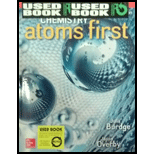
Concept explainers
Interpretation: The resonance structure of the adenine molecule which is part of the DNA should be drawn.
Concept Introduction: Sometimes the
All the possible resonance structures are imaginary whereas the resonance hybrid is real. Any of the possible structure does not exist as such like a stable real molecule. So it is not possible to isolate one resonance structure.
While drawing resonance structure of a molecule some rules should be followed where the position, over whole charge and chemical framework remains intact. Also only π and nonbonding electron has been moved in all the three resonance structures.
Want to see the full answer?
Check out a sample textbook solution
Chapter 6 Solutions
Chemistry: Atoms First (Comp. Instructor's)
- Aspirin is made from salicylic acid, which has this Lewis structure: (a) Which is the longest carbon-carbon bond? (b) Which is the strongest carbon-oxygen bond? (c) Draw resonance structures for this molecule.arrow_forwardAnswer the questions in the table below about the shape of the phosgene (COCI,) molecule. How many electron groups are around the central carbon atom? Note: one "electron group" means one lone pair, one single bond, one double bond, or one triple bond. What phrase best describes the arrangement of these electron groups around the central carbon atom? (You may need to use the scrollbar to see all the choices.) (choose one)arrow_forwardComplete the following statements about the molecule COS. Please note that ALL atoms in this molecule obey the octet rule. The molecule COS has total valence electrons. The molecule COS should be drawn with C in the middle, O to the left of the C, and S to the right of the C. After drawing the Lewis structure for COS using the above information, it is evident that the three-dimensional shape (or geometry) of the molecule is , with a bond angle of degrees.arrow_forward
- Please don't provide handwriting solutionarrow_forward< Complete the following structural formula for a neutral molecule by adding H atoms to complete the valence of each atom. Do not introduce any double or triple bonds. Then complete the Lewis diagram by adding any unshared electron pairs needed, so that each atom except H has a complete octet. [Review Topics] [References] Use the References to access important values if needed for this question. Br Br C—C— Write the molecular formula in the order CHX, where X stands for Cl or Br. Submit Answer The number of unshared pairs in the Lewis diagram unshared pair(s). Retry Entire Group 9 more group attempts remaining Previous Email Instructor Next Save and Earrow_forward10.) The structural formula of a certain aldehyde (related to formaldehyde) is H3C-CH2-CHO. Draw a Lewis structure for this aldehyde and determine the number of bonds present. Note that a single or a double or a triple bond counts as one bond. Write the number, not the word.arrow_forward
- Following is a molecule with polar bonds whose shape was obtained using the VSEPR theory. Specify the molecular shape of this molecule, and whether the molecule is polar or nonpolar. (Hint: In terms of polarity, see whether the dipoles in the molecule cancel or not. A molecule containing polar bonds can be nanpolar if the dipoles cancel each other. You can imagine the dipoles as ropes pulling on the central atom–If the pulls cancel each other, that is, the central atom cannot move, then the molecule is nonpolar. If on the other hand the opposite is true, then the molecule is polar.) O trigonal pyramidal shape, nonpolar O trigonal planar shape, nonpolar O tetrahedral shape, polar O trigonal pyramidal shape, polar O trigonal planar shape, polararrow_forwardWhat is the structural diagram of CH2ClF without lone pairs? Also what is its Electronegativity bond after you subtract the smaller from the greater value along with its bond type, total lone pairs of electrons and total bonding pairs of electrons? Lastly, is it polar or non polar (polar molecularity) ?arrow_forwardDraw a Lewis structure for the compound whose skeletal structure is provided to you below. Don't forget to draw in the H atoms! CH₂ HC CH 11 HC — CH, - Draw the Lewis structure by placing atoms on the grid and connecting them with bonds. Include all lone pairs of electrons.arrow_forward
- Use Lewis theory to determine the formula for the compound that forms between each of the following pairs of elements. Ca and Te Express your answer as a chemical formula. Mg and Br Express your answer as a chemical formula. Na and S Express your answer as a chemical formula. In and O Express your answer as a chemical formula.arrow_forwardDraw the resonance structure showing by the arrows for the following molecules: Molecules 1 & 2 are in the image ( IMG_9740.jpg ) Molecule 3 is in the image ( IMG_9741.jpg ) Thank you!arrow_forwardPlease refer to the example image to answer. You must use CER, claim-evidence-reasoning. Make sure that your answer is CLEAR and explained well. Claim is your answer to the question. Evidence is from the image and reasoning is your explanation. Proper evidence for all Lewis structures include: Most electronegative atom must be in the center. Octet of electrons surrounding each atom. Total number of electrons depicted equals same total number of valence electrons from each participating atom. Make sure to refer to the example image because it shows the correct Lewis structures. The question you're answering is about the students drawing of CH20.arrow_forward
 Chemistry: The Molecular ScienceChemistryISBN:9781285199047Author:John W. Moore, Conrad L. StanitskiPublisher:Cengage Learning
Chemistry: The Molecular ScienceChemistryISBN:9781285199047Author:John W. Moore, Conrad L. StanitskiPublisher:Cengage Learning Organic Chemistry: A Guided InquiryChemistryISBN:9780618974122Author:Andrei StraumanisPublisher:Cengage Learning
Organic Chemistry: A Guided InquiryChemistryISBN:9780618974122Author:Andrei StraumanisPublisher:Cengage Learning

